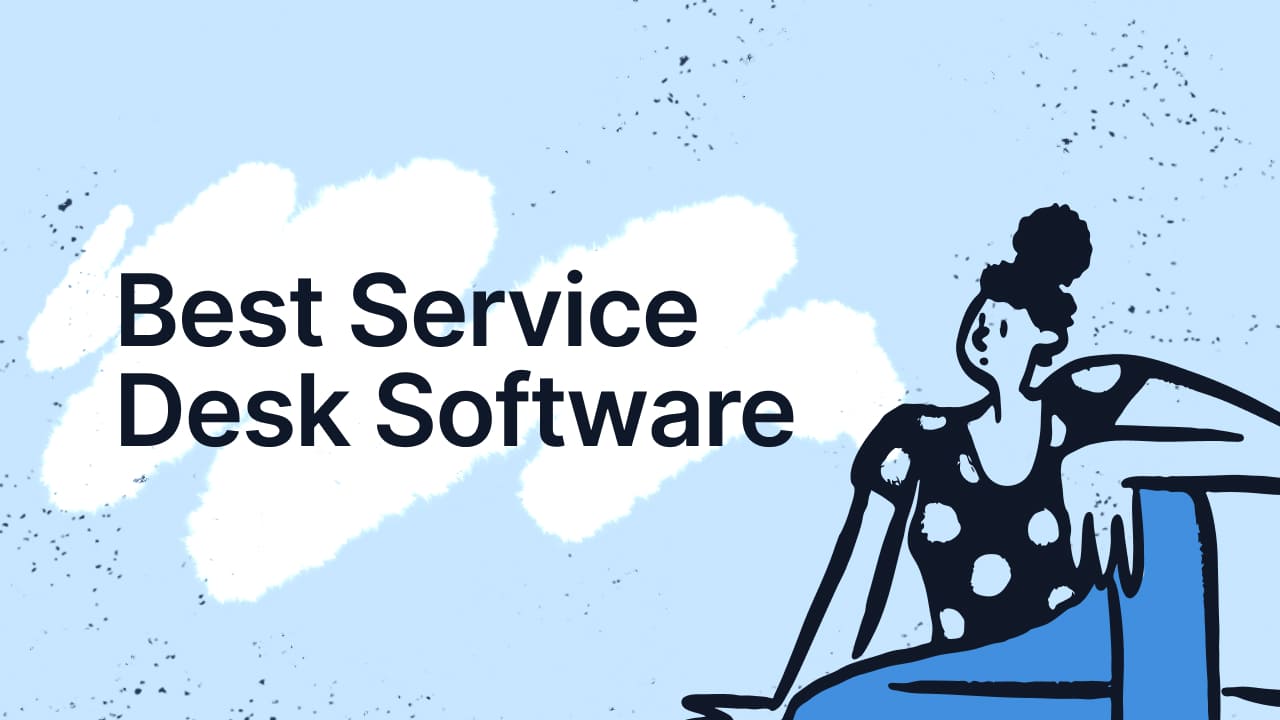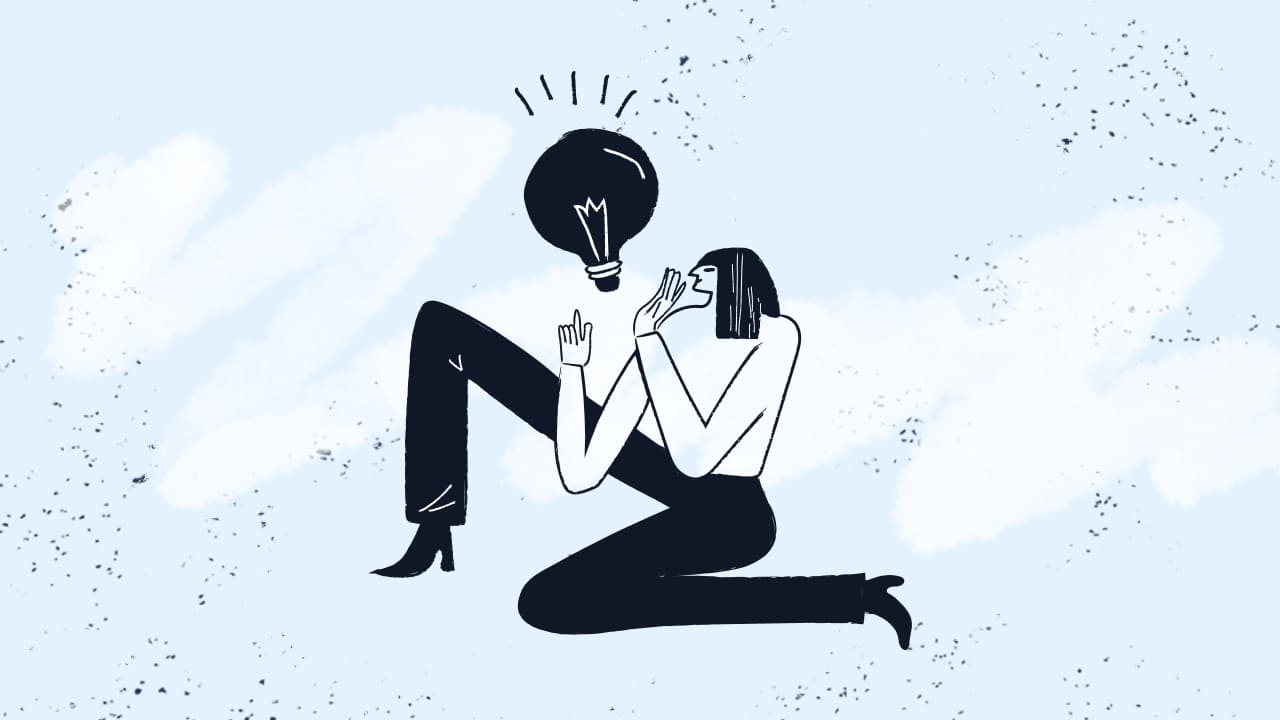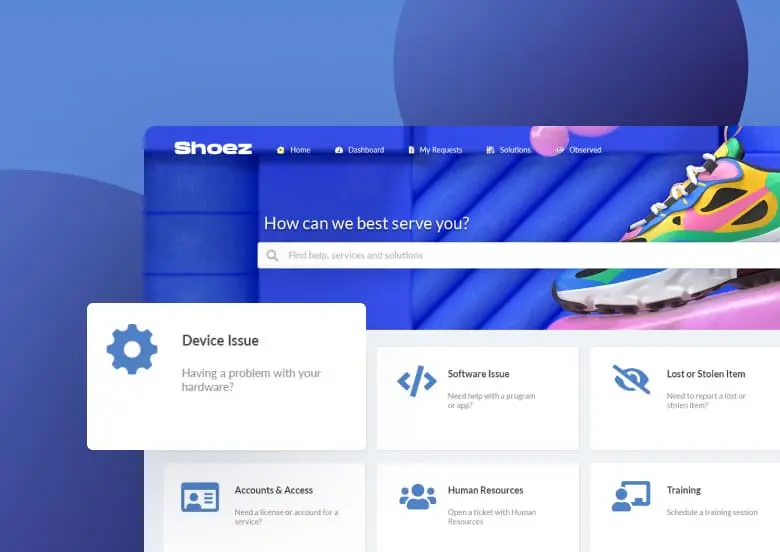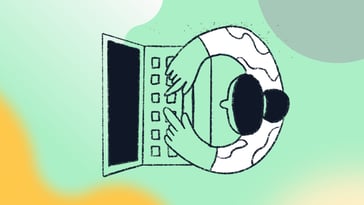When technical problems arise at work—whether a software glitch or network downtime—getting quick support can mean the difference between an hour of lost productivity and a smooth recovery. The solution? A well-functioning service desk.
For those unfamiliar, a service desk is a gateway between employees and their IT teams, ensuring technology runs smoothly while handling issues and requests with minimal disruption. But service desks do more than just troubleshoot and fix immediate problems. They're part of a bigger approach called IT Service Management (ITSM), which looks after all of a company's technology.
In this guide, we’ll break down the fundamentals of service desks and explain how they fit into a larger system of best practices.
What is a service desk?
A service desk is a central help center for all IT-related needs. It's a communication center that provides a single point of contact (SPOC) between a company and its customers, employees, and/or business partners.
It's a team of people supported by special software (service desk software) who help employees with any technology issues or requests they might have.
Think of the service desk as the front door to your company's IT department. When you have a problem with your computer, need access to a new software program, or have any questions about the technology you use at work, the service desk is your first point of contact.
A brief history of the service desk
Service desks have evolved considerably over time. In the 1980s, they started as basic "help desks" primarily focused on break-fix support—fixing things when they went wrong.
As businesses grew more dependent on technology, the service desk evolved into a broader IT support function in the 1990s, aligning with the emerging ITIL framework.
Today, modern service desks incorporate advanced technologies like workflow automation, Artificial Intelligence (AI), and proactive support functions to fix and prevent issues.

Best Service Desk Software in 2024: Top 14 Tools
What does a service desk do?
A service desk is the primary interface between IT service providers and users. It manages incidents, service requests, and user communications, serving as a centralized hub for IT support and service delivery.
Key objectives of a service desk include:
- Restoring normal service operations quickly
- Minimizing the business impact of service interruptions
- Ensuring high levels of user satisfaction
- Supporting business processes and business as usual (BAU) by providing efficient IT services
A great service desk is:
- Responsive: They address issues quickly and keep users informed through self-service tools.
- Knowledgeable: The team is well-trained and can handle a wide range of issues.
- User-friendly: They communicate clearly and make it easy for people to get help.
- Proactive: They don't just fix problems; they try to prevent them from happening in the first place.
How does a service desk work?

Here’s how a typical service desk process works:
- A user submits a request: This can be done through various channels—email, phone, chat, or a self-service portal.
- Ticket creation: The service desk creates a "ticket" to document the issue or request.
- Ticket categorization: The service desk team prioritizes the ticket based on the issue's urgency and impact on business operations.
- Resolution: The desk either solves the problem on the spot or escalates it to the relevant IT team if it's more complex.
- Updates: Users are kept informed of progress, and once the issue is resolved, the ticket is closed.
Why are service desks important?
Service desks play a crucial role in businesses for several reasons:
- They keep things running: By quickly addressing IT issues, they help maintain productivity.
- They improve user satisfaction: Employees can rely on the service desk for fast, effective help, making them more satisfied with the tools they use.
- They provide insights: Tracking service requests helps identify recurring problems, which can lead to improvements in IT systems and processes.
- They support business growth: As companies grow and change, service desks help manage the increasing complexity of IT needs.
Types of service desks
Service desks come in different forms depending on the needs of the organization:
- Internal service desk: These are managed in-house, with a dedicated IT team within the company.
- External service desk: Some organizations outsource their service desk operations to third-party providers.
- Virtual service desk: Operate remotely, offering support across different locations, often around the clock.
Service desk vs. help desk
While often used interchangeably, a service desk and a help desk are different.
- Help desks are reactive and focused mainly on fixing immediate technical problems.
- Service desks take a broader view, aligning IT services with business objectives. They don't just respond to issues but work proactively to support the organization's technology strategy.

The Complete Guide to The IT Help Desk: Definition, Features, And Benefits
Best practices for running a service desk
To ensure consistent quality and efficiency, there are service desk best practices to follow that can help deliver fast, effective support:
- Use a ticketing system: Every request or incident is tracked through a ticket, ensuring issues are recorded, monitored, and resolved in a structured way.
- Establish clear Service level agreements (SLAs): SLAs define the expected timeframes for resolving different types of requests, ensuring transparency and accountability.
- Focus on first contact resolution: The faster an issue is resolved, the better. Prioritizing solutions at the first point of contact boosts efficiency and customer satisfaction.
- Offer multi-channel support: Employees should be able to contact the service desk through various means—whether by phone, email, chat, or a self-service portal.
- Proactive communication: Keeping users informed of issue statuses helps manage expectations and build trust with the IT team.

How to Improve IT Support? 9 Ideas For Your Service Desk
ITIL practices and their role in service desk operations
ITIL, the go-to ITSM framework, provides a set of best practices for delivering IT services, including how a service desk should operate.
These practices ensure that IT services run smoothly, problems are addressed efficiently, and changes are managed with minimal disruption.
Let's walk through some of the key ITIL practices relevant to service desks:
Incident Management
Incident Management is all about restoring normal operations when something goes wrong. An incident can be anything from a network outage to a malfunctioning printer. The goal of Incident Management is to resolve these issues as quickly as possible to minimize the impact on operations.
How it works within a service desk:
- When an issue occurs, the service desk logs it as an incident in the system.
- The service desk team diagnoses the problem, either fixing it directly or escalating it to specialized IT staff if necessary.
- Progress is tracked, and the user is kept informed until the incident is resolved.
A key measure of incident management is how quickly and efficiently issues are resolved, which helps ensure that processes continue with minimal downtime.
Problem Management
While Incident Management focuses on addressing individual issues, Problem Management is about finding the root cause of recurring problems to prevent them from happening again. It involves identifying underlying causes and implementing long-term fixes, often after an incident has been resolved.
How it works within a service desk:
- If a pattern of incidents is identified (e.g., multiple users reporting the same issue), the service desk will escalate it as a "problem."
- The IT team investigates the root cause, often using data from incident reports, and works on a permanent solution.
- The solution might involve changes in processes, software updates, or infrastructure improvements.
Change Management
Change Management ensures that changes to IT systems, whether large or small, are planned, tested, and implemented in a controlled manner to minimize risk. These changes can range from software updates to implementing new systems or services.
How it works within a service desk:
- When a change is proposed (for example, a software upgrade), the service desk logs a change request.
- The change request is reviewed and approved by the Change Advisory Board (CAB), which assesses the risks and impact of the change on the business.
- Once approved, the change is scheduled and implemented with minimal disruption to services.
- After the change is made, the service desk monitors the system to ensure it works as expected, and any issues are addressed.
Service desk software
Service desk software is a tool that consolidates and streamlines all aspects of service delivery, making it the backbone of any IT support operation. It provides a structured environment where support agents handle incidents, track tasks, and monitor system health, making it essential for businesses with complex IT needs. Many solutions also offer remote support capabilities that allow teams to assist users from anywhere, which has become increasingly important with the rise of remote work.
Organizations typically choose a service desk solution based on their specific needs, such as the size of their IT department, the complexity of their infrastructure, or integration requirements. Some companies may prioritize solutions that offer extensive customization, while others might prefer a tool with more out-of-the-box functionality and a simple setup. Features like automation, scalability, and analytics are also key factors in the decision-making process. We'll cover more about service desk capabilities in the following section.
The flexibility of service desk software means it can be tailored to different industries, not only IT support. So, you can use it for facilities management or even HR. The wide variety of options available—from lightweight tools for small businesses to enterprise-grade solutions—ensures that organizations can find software that matches their support needs and growth plans.
Service desk features
Some of the most common and useful features to look for on Service Desk software include:
- Ticketing systems: Centralizes incidents, service requests, and tasks, making it easy for IT teams to track, prioritize, and resolve tickets efficiently.
- Knowledge Management: Provides a self-service portal for users and an internal knowledge base for service desk agents, which supports problem management and incident resolution.
- Self-service portal: A self-service portal allows users to resolve common issues on their own by accessing a knowledge base, FAQs, or submitting service requests without needing direct support.
- Asset Management tools: These tools allow IT teams to manage hardware, software, and other IT resources. The system tracks assets through their entire lifecycle, providing data on usage, ownership, maintenance, and disposal. Asset Management also helps connect assets to incidents or changes, giving service desk agents quick access to relevant information during support interactions.
- Service Level Management: These tools ensure that SLAs are monitored and met. The system can generate reports and send alerts when service levels are in jeopardy, ensuring that users get timely resolutions.
- Automation: Automates routine tasks like ticket routing or even responding to common issues, allowing IT staff to focus on complex problems.
- Reporting and analytics: Dashboards and reports provide insights into ticket resolution times, asset performance, user feedback, and SLA adherence. This valuable data supports continuous improvement across all ITIL practices.
Spoiler: InvGate Service Management ticks all the boxes and beyond. InvGate offers a service desk software solution with a powerful ticketing system, intuitive interface for all teams, and a dedicated support team who is ready to help you with your ITSM implementation journey.
You can see it for yourself in action with our free 30-day trial! No strings attached.
The future of the service desk
While service desks started as simple help centers, they have evolved into complex, technology-driven operations essential for modern businesses. Today, they face challenges that go far beyond basic troubleshooting.
Fortunately, technological advancements are helping service desks meet these challenges:
-
Artificial Intelligence (AI) and Machine Learning:
-
AI-powered chatbots can handle simple queries, freeing up human agents for more complex issues.
-
Machine learning algorithms can predict common problems and suggest solutions.
-
-
Automation:
-
Routine tasks like password resets or software installations can be automated.
-
This speeds up resolution times and reduces the workload on human agents.
-
-
Advanced analytics:
-
Data analysis tools help identify patterns in IT issues.
-
This allows for proactive problem-solving and better resource allocation.
-
-
Self-service portals:
-
User-friendly interfaces allow employees to solve simple problems on their own.
-
These portals often include knowledge bases and step-by-step guides.
-
-
Remote support tools:
-
Advanced remote access software allows technicians to troubleshoot issues from anywhere.
-
This is especially crucial with the rise of remote work.
As technology continues to advance, we can expect service desks to become even more sophisticated:
-
Predictive support using IoT data from devices
-
Virtual reality for immersive, hands-on remote assistance
-
Even greater integration with business processes and decision-making
Service desk operations have come a long way from simple help centers. They now play a strategic role in Service Management for organizations, balancing advanced technology with human expertise to keep businesses running smoothly.
-

AI + Service Desk: 7 Ways to Boost Service Desk Capabilities
Conclusion
The service desk is the backbone of IT support in modern organizations. Here are the key points to remember:
- A service desk is your go-to resource for all IT-related issues and requests at work.
- It handles a wide range of tasks, from solving technical problems to managing software requests.
- Service desks play a crucial role in maintaining productivity and user satisfaction.
- They're evolving with technology, using tools like AI and automation to provide better support.
- Despite technological advances, the human touch remains important in service desk operations.
Understanding the role and importance of service desks can help you make the most of this valuable resource in your workplace. Next time you face an IT issue, you'll know exactly where to turn for help.
















